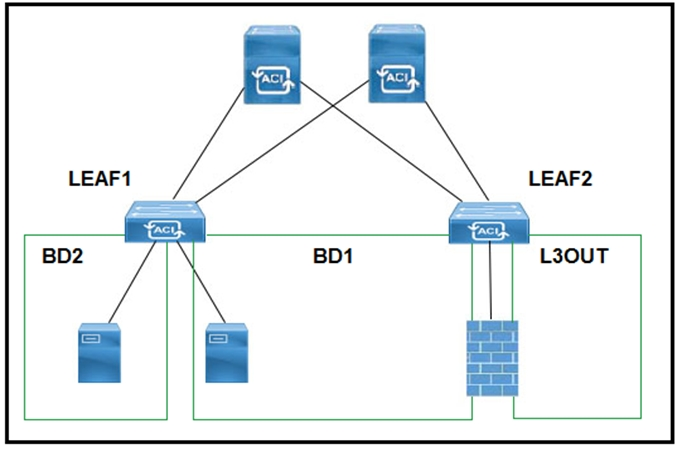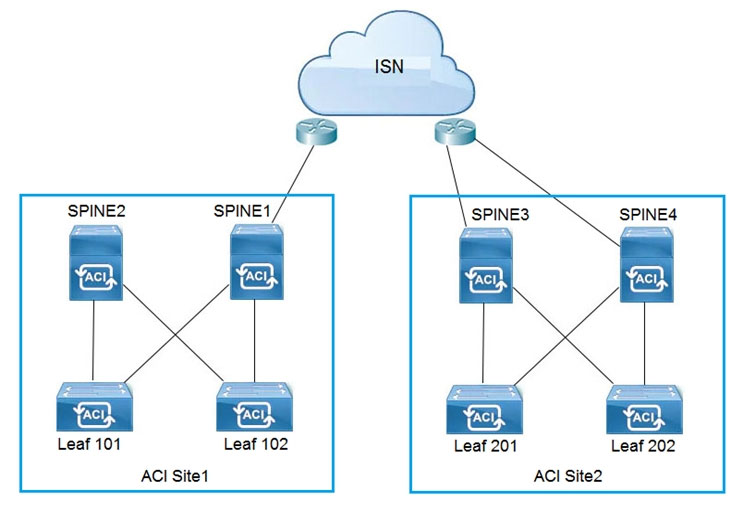Cisco 300-610 Exam
By
John William,
in Cisco Certified Network Professional Data Center Exams
Prepare Cisco 300-610 Exam Questions
Question No 1:
What is an advantage of using OTV as compared to VPLS for data center redundancy?
A. prevents loops on point-to-point links
B. provides head-end replication
C. uses a proactive MAC advertisement
D. provides full-mesh connectivity
Answer: A
See More Questions
Hi!
Help with answers to questions:
Question No 1:
Which two actions are the Cisco best practices to configure NIC teaming load balancing for Cisco UCS B-Series blades that are connected to the Cisco ACI leaf switches? (Choose two.)
A. Create vPC+
B. Enable LACP active mode
C. Create PAgP
D. Create vPC
E. Enable MAC pinning
Question No 2:
An engineer deployed a Cisco ACI fabric and noticed that the fabric learns endpoints from subnets that are not configured on a bridge domain. To meet strict security requirements, the engineer must prevent this behavior. Which action must be taken to prevent this behavior?
A. Activate Enable Data Plane Endpoint Learning
B. Implement Pervasive Gateway
C. Configure Static Binding
D. Enable Enforce Subnet Check
Question No 3:

Refer to the exhibit. A customer experiences resource overconsumption on one of its border leaf switches. Which action should be taken to reduce the consumption on this switch?
A. Disable VRF Policy Control Enforcement
B. Disable IP Data Plane Learning
C. Migrate L3Outs to another switch
D. Disable Remote EP Learning
Question No 4:
Which approach does Cisco ACI use to achieve multidestination packet forwarding between leaf switches in the same fabric?
A. Map VXLAN VTEP to the multicast group
B. Map VXLAN to PIM-SM protocol
C. Map VXLAN VNI to the multicast group
D. Map VXLAN to PIM-DM protocol
Question No 5:
What are two characteristics of network-centric design in Cisco ACI? (Choose two.)
A. There is open communication between EPGs
B. EPGs are used for microsegmentation
C. EPGs are different security zones
D. Applications define the network requirements
E. A bridge domain has one subnet and one EPG
Question No 6:
A network engineer configured an active-active firewall cluster that is stretched across separate pods in the Cisco ACI fabric. Which two implementation setups for anycast services are available? (Choose two.)
A. Modify the Cisco ACI contract scope
B. Modify the MAC address on the second firewall
C. Configure the firewalls behind an EPG subnet
D. Deselect No Default SVI Gateway under EPG Subnet
E. Deploy a Layer 4 to Layer 7 service graph with PBR
Question No 7:
An engineer designs a Cisco ACI Multi-Pod solution that requires a pair of active-standby firewalls in different pods for external connectivity. How should the firewalls be implemented?
A. PBR for routed firewalls
B. separate L3Out peerings for routed firewalls
C. routed firewall for the default gateway
D. transparent firewalls
Question No 8:
Which firewall connection allows for the integration of service nodes in transparent mode with a Cisco ACI Multi-Pod
setup?
A. active-standby mode across pods
B. active-active mode per pods for communication between internal endpoints
C. active-standby mode per pods for communication between endpoints and external networks
D. active-active mode across pod
Question No 9:

Refer to the exhibit. Which two configuration steps are required in ISN for Cisco ACI Multi-Site setup? (Choose two.)
A. Connect Spine2 to ISN routers.
B. Configure BIDIR-PIM throughout the ISN
C. Increase ISN MTU to support the maximum MTU that is sent by endpoints
D. Configure OSPF between spines and ISN routers
E. Enable IGMPv3 on ISN routers
Question No 10
An engineer must implement a full mesh Cisco ACI Multi-Site architecture. Which action must be taken on each spine to accomplish this goal?
A. Configure BGP-EVPN Router-ID
B. Configure Multi-Pod Data-Plane TEP
D. Configure Overlay Unicast TEP
E. Configure Overlay Multicast TEP
Question No 11:
An engineer creates the objects that must be deployed at each site in Cisco ACI Multi-Site Orchestrator. Which action should be taken before the schema can be associated with the newly configured site?
A. Configure a provider for the Cisco ACI Multi-Site Orchestrator
B. Import existing policies from an existing tenant to Cisco ACI Multi-Site Orchestrator
C. Configure the Infra Site-Specific Settings
D. Attach the templates to the newly configured site
Question No 12:
An engineer configures a new Cisco ACI Multi-Pod setup. Which action should be taken for fabric discovery to be successful for the nodes in Pod 2?
A. Select the Route Reflector field in Pod Peering
B. Enable the DSCP class-cos translation policy for Layer 3 traffic
C. Configure POD 2 Data Plane TEP under the Pod Connection Profile
D. Add the IPN subnet under the Fabric External Routing Profile
Question No 13:
How does Cisco ACI manage the STP BPDUs between two pods?
A. Cisco ACI spines perform ingress replication for STP BPDUs
B. Cisco ACI spines suppress STP BPDUs to be forwarded to other pods
C. BPDUs are forwarded over IPN using the bridge domain GIPo multicast address
D. Special multicast group 239.255.255.255 is used to forward STP BPDUs
Question No 14:
How does Cisco ACI manage the STP BPDUs between two pods?
A. Cisco ACI spines perform ingress replication for STP BPDUs
B. Cisco ACI spines suppress STP BPDUs to be forwarded to other pods
C. BPDUs are forwarded over IPN using the bridge domain GIPo multicast address
D. Special multicast group 239.255.255.255 is used to forward STP BPDUs
Question No 15:
What are two characteristics of Cisco ACI interaction with MSTP? (Choose two.)
A. A Cisco ACI leaf flushes all local endpoints in the received EPG when an MSTP TCN frame is received.
B. A static path binding is required for native VLAN to carry the MST BPDUs in existing EPGs.
C. Mis-cabling protocol is used to snoop the MSTP TCN packets.
D. A dedicated EPG must be created for the native VLAN ID with static bindings toward the MSTP-enabled switches.
E. The PVST simulation must be configured on external network switches to support MSTP.
Question No 16:
What two actions should be taken to deploy a new Cisco ACI Multi-Pod setup? (Choose two.)
A. Configure anycast RP for the underlying multicast protocol
B. Configure the TEP pool of the new pod to be routable across the IPN
C. Configure MP-BGP on IPN routers that face the Cisco ACI spines
D. Increase interface MTU for all IPN routers to support VXLAN traffic
E. Connect all spines to the IPN

Information About Cisco 300-610 Exam
Vender: Cisco
Exam Code: 300-610
Exam Name: Designing Cisco Data Center Infrastructure
Number Of Questions: 135
Certification Name: Cisco Certified Network Professional Data Center
Exam Language: English
Questions Type: MCQs
Material Format: PDF & Web Practice Test Software